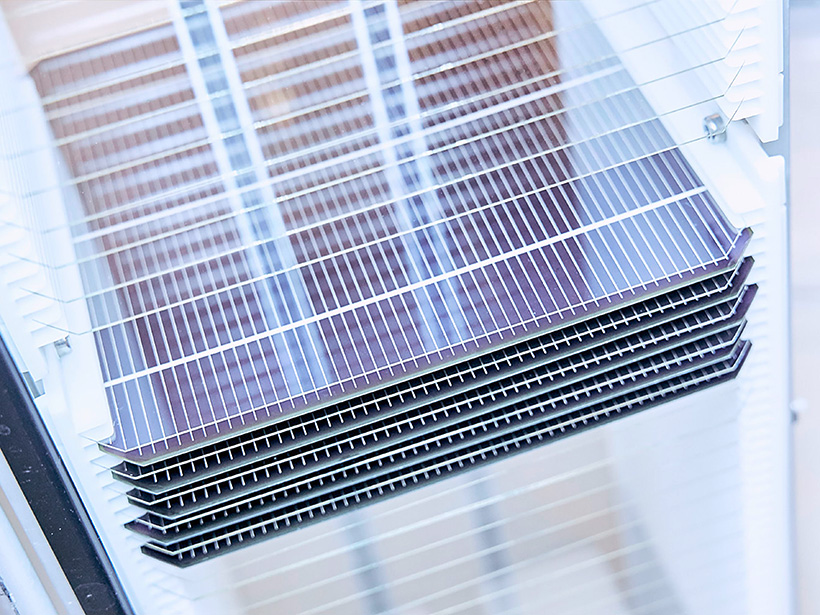For decades, traditional silicon-based photovoltaic cells have been the industry standard for converting sunlight into electricity—but as a photon-absorbing material, silicon is not actually all that efficient. On average, solar panels made with crystalline silicon convert between 18% and 22% of the Sun’s energy into usable electricity, with an upward theoretical limit of 33%. Despite this limitation, crystalline silicon photovoltaic cells account for 95% of the solar cell market.
By layering traditional silicon cells with a mineral called perovskite, however, materials scientists are engineering more efficient tandem solar cells that significantly boost efficiency, without derailing well-established silicon cell manufacturing pathways.
“Tandem solar cells have significantly higher energy-conversion efficiency than today’s state-of-the-art solar cells. Thus, tandem cells can contribute to lowering the cost of solar energy, in particular in rooftop solar systems, where high efficiency is of central importance,” Dirk Weiss, a materials scientist with First Solar, recently wrote in Joule. “A new generation of low-cost tandem cells is needed to enable widespread implementation. Hybrid-perovskite top cells combined with silicon bottom cells are currently the most popular low-cost tandem candidate under development.”
In a new perspective, published in Applied Physics Letters, a team led by Laura Miranda Pérez, head of materials research at Oxford PV in the United Kingdom, and Chris Case, the chief technology officer at Oxford PV, presents a case for commercializing tandem solar cells by combining existing silicon cell technology with synthetic variants of the perovskite.
The mineral perovskite, also known as calcium titanate, was discovered in the Ural Mountains in 1839, but the perovskite used in solar cells is synthesized in a lab from readily available components. These perovskite solar materials can be applied in very thin layers, making them an ideal material to add to existing silicon cell manufacturing processes.
“Perovskites can enhance and advance silicon technologies without interrupting manufacturing.”
“Perovskites are the perfect partner for a tandem system with silicon,” said Miranda Pérez.
By adding perovskite, which more efficiently captures the blue region of the solar spectrum, to silicon, which targets the red region, Oxford PV has set a record solar cell efficiency of more than 29.5%. With further development, efficiencies could reach as high as 39%, said Miranda Pérez. Other research teams have demonstrated that photovoltaic cells made with only perovskite and no silicon are also viable, but these solar cells cannot exceed the practical efficacy of any single solar cell, which is around 26%. The multijunction or tandem approach of Oxford PV is the best way to break the 26% practical efficiency barrier, said Miranda Pérez.
“Of all the alternative solar cell technologies, silicon/perovskite tandem cells are proving to be the most promising because they offer a degree of tunability that you don’t have with a lot of the competing technologies,” said Joseph Berry, a senior research scientist at the National Renewable Energy Laboratory in Golden, Colo., who was not involved in the new study. “This new perspective does a great job of showing how perovskites can enhance and advance silicon technologies without interrupting manufacturing.”
Scaling Sustainably
Oxford PV, a company cofounded in 2010 by University of Oxford physicist Henry Snaith, has focused on developing perovskite-on-silicon tandem cells since 2014. Initially, ensuring the long-term stability of perovskite was the principal challenge, but current perovskite-on-silicon tandem cells have passed key accelerated stress tests for solar cells, known as the IEC 61215, established by the International Electrotechnical Commission. The tandem cells are expected to meet or exceed the industry expectation of 25 years or more of durability in the field.
The team’s next step is to ramp up production at Oxford PV’s factory in Brandenburg, Germany, which houses the world’s first perovskite-on-silicon production line, with a capacity of 100 megawatts. “The line build-out has been completed, and we will be taking tandem cells into the market next year,” Miranda Pérez said.
Initially, the company’s solar cells will be made available for residential rooftops, where space is at a premium. With additional production capacity, Oxford PV has set its eyes on commercial rooftops and utility-scale applications. “As a company we are very concerned about the climate crisis, and the best way we can play our part is to deploy this technology as quickly as we can,” said Miranda Pérez.
As countries commit to reducing emissions to meet U.N. climate goals by 2050, solar power is projected to become more pervasive. “I think tandem technologies will be requisite to hit future solar and climate goals,” Berry said.
“We want to help people understand the huge potential of perovskite-on-silicon tandem technology to boost the efficiency of solar installations and to help the world reach the goal of providing sustainable energy for all,” said Miranda Pérez.
—Mary Caperton Morton (@theblondecoyote), Science Writer
Citation:
Morton, M. C. (2021), Better together: Perovskites boost silicon solar cell efficiency, Eos, 102, https://doi.org/10.1029/2021EO163469. Published on 23 September 2021.
Text © 2021. The authors. CC BY-NC-ND 3.0
Except where otherwise noted, images are subject to copyright. Any reuse without express permission from the copyright owner is prohibited.

